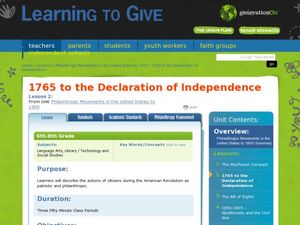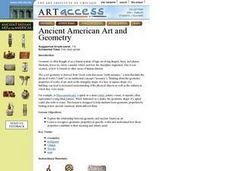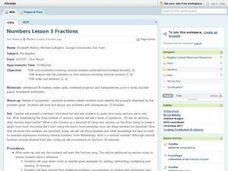Curated OER
When It Comes to Sound, I'm All Ears!
Students discover how sound is produced and how sound travels. Through inquiry, problem solving and hands-on activities, students explore high and low sounds and the mediums in which sound travels best.
Curated OER
How Quickly Disease Spreads
Students demonstrate how quickly disease spreads and the importance of protective measures with communicable diseases. They examine past epidemics such as the Bubonic Plague and make predictions about future epidemics.They compare and...
Curated OER
How Can We Make a Model of Lungs?
Fifth graders examine the function of the lungs and create a model of the lungs. Using a plastic cup, drinking straw, plastic bag, small balloon, and a rubber band, they follow step-by-step directions to construct simulated lungs. ...
Curated OER
How Bright are the Stars?
Students observe the brightness of stars and are introduced to the concept of apparent brightness as a measure of how much light hits a detector of a surface area during a given time. In this star lesson, students make connections...
Curated OER
Welcome to My World!
Students use maps to locate information. They read the story, "It Looked Like Spilt Milk", view images of the continents and discuss the various continents. Afterward, they make their own Atlas to record information that they can later...
Curated OER
Rooster's Off To See the World Number-Sense
Students recognize how numbers are used in number stories. In this Rooster's Off To See the World lesson, students participate in the story. Students complete a number activity and work on the computer to illustrate a number...
Curated OER
Introduce Vocabulary: Welcome to the Ice House
Students study tier two vocabulary words. In this vocabulary instructional activity, students explore new vocabulary words found while reading Welcome to the Ice House. Students assess the meaning of their new vocabulary words and record...
Curated OER
Closer to the Ground
Students understand the idea of a nonprofit organization, the service donated by others, and how it helps a community. In this philanthropic lesson, students explore the types of nonprofits that would be beneficial to a school and what...
Curated OER
1765 to the Declaration of Independence
Students research philanthropists of the American Revolution. In this philanthropy lesson, students watch the video Johnny Tremain and analyze the characters and determine their motives. Students read the Declaration of Independence...
Curated OER
The Roadmap to the Jewish Golden Age of Spain
Learners discover, through analysis of media and of primary source historical documents, how Jews achieved high levels of assimilation and acceptance under Islamic rule during the Golden Age of Spain, from the tenth to the twelfth century.
Curated OER
The Nile: A Gift to Egypt
Sixth graders discover the Egyptian culture. In this Nile River lesson, 6th graders examine why the river is so important to Egypt.Students study the religions, geography and the people of Egypt. Students create an exhibit where...
Curated OER
Deserts: How Do You Define One?
Second graders identify what constitutes as a desert by reading a habitat checklist. In this environment lesson, 2nd graders read a nature website to discover facts about the desert and where they are located. Students...
Curated OER
Postcard to Mom
Students research the stages a lobster larvae passes through. in this lobster lesson plan, students pretend as if they are the lobster larvae and write a postcard to their lobster mother describing the changes they have been through....
Curated OER
What Animals Need to Live
Fourth graders read "Habitat: What Animals Need to Live" then create a Venn diagram for herbivore, omnivore, and carnivore. In this animal survival lesson, 4th graders determine where different animals need to live depending on what they...
Curated OER
What's On Your Plate?
If you are teaching in a Christian school, Sunday School, or home school environment, then this lesson plan would be appropriate. The class discusses Biblical traditions and culture and how that related to current Christian beliefs. They...
Curated OER
Sea Changes: A New England Industry
Young scholars conduct research in order to use primary and secondary sources. They interpret and analyze information from textbooks and nonfiction books for young adults, as well as reference materials, audio and media presentations,...
Curated OER
What Can I Do?
Students identify their feelings and examine constructive ways of handling conflict. In this conflict lesson students discuss how to communicate their feelings and resolve conflicts.
Curated OER
Synthesis of Information
Locating and synthesizing information is an essential part of the research process but can be overwhelming for many young writers. Eliminate some of the stress and confusion, this resource suggests, by separating these steps. To focus...
Curated OER
Key It Correctly!
Third graders receive instruction on how to use a keyboarding device or computer. They show the proper technique to type each key as it is called out by the teacher, and also focus on using correct posture when sitting at a computer.
Curated OER
Ancient American Art and Geometry
Students explore the relationship between geometry and ancient American art. They see how to recognize geometric properties in specific works and explain how these properties contribute to their meaning and artistic merit.
PB Works
Numbers Lesson 3 - Hershey Bar Fractions
Talk about delicious math! Pupils solve problems involving rational numbers and analyze real-life problems to find solutions in a pre-algebra class. They discuss the sections of a Hershey's bar in terms of fractions and decimals before...
Curated OER
Multiplying Exponents vs. Powers of Powers
Use the power of a power property to solve exponential functions. The lesson refers to differentiating between multiplying or adding exponents to find the value, and how to find the product of a power of a power.
Curated OER
Does it Measure Up?
Use this fun activity with youngsters learning how to use rules for measurement. Each is provided with six steps that direct them to draw specific things with specific heights or lengths. For example, they start by drawing a tree that is...
Curated OER
Applying Phonetic Principles
Young readers develop their phonetic skills by using a nifty tool called a word pocket. They use the tool to help them organize individual letters that they have at their desks to spell entire words and to construct beginning and ending...























